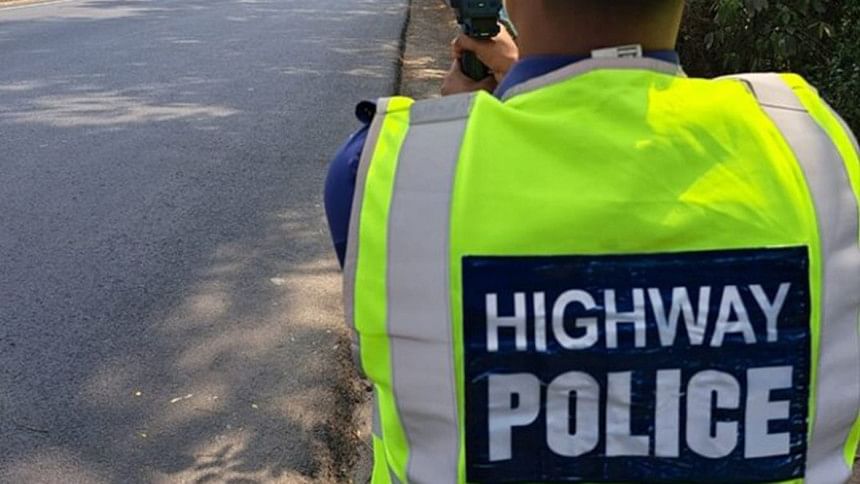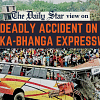Highway Police struggling amid resource crunch

The special police unit, which was established nearly two decades ago to ensure safety and security on the highways, continues to struggle to prevent robberies and other crimes.
Highway Police officials cited insufficient manpower, inadequate logistics support, and the absence of a modern, technology-driven policing system as key factors behind the unit's struggles.
Although the officials could not immediately say how many robberies on the highways took place in recent months, data from the Police Headquarters showed the number of robbery cases in general was 171 in January and 153 in February this year, compared to 114 and 121 in the same months last year.
In recent months, armed gangs ambushing buses, trucks, and private vehicles have made headlines very often. News reports show regional roads are particularly vulnerable after dark.
Returning expatriates, businessmen, and goods-laden trucks are among the most frequent targets. Many victims refrain from filing cases due to the legal hassles and a lack of confidence in law enforcement. They opt for general diaries that often lead to no action.
The most shocking incident took place on February 17, when a gang took charge of a Rajshahi-bound bus from Dhaka near Mirzapur in Tangail. They assaulted passengers before fleeing with cash, mobile phones, and jewellery.
We have 90 vehicles and around 3,000 members, but we need at least 250 vehicles and 6,000 officers
On February 21, armed criminals robbed passengers and drivers on the Dhaka-Sylhet highway, taking jewellery, cash, and mobile phones. In another incident on February 23, robbers blocked a highway in Patnitala, Naogaon, with logs and attacked a BRTC bus and a microbus, stealing Tk 3 lakh in cash and valuables. A gang looted cash and mobile phones from teachers and students on an educational trip in Tangail's Ghatail upazila on February 25.
On March 1, robbers attacked a microbus carrying a Bangladeshi expatriate in Pabna's Santhia upazila, injuring three people and looting valuables. A day later, a moving bus near Savar's Bank Town area was ambushed in broad daylight by armed robbers.
In response to these incidents, police have prepared a list of 1,446 suspects, including individuals who have been formally charged or convicted in past highway robbery cases.
Md Shafiqul Islam, deputy inspector general (operations) of Highway Police, told The Daily Star that the force had already sent the list to the Police Headquarters with a request to launch a coordinated drive by district police and other units concerned.
UNDERSTAFFED, ILL-EQUIPPED
With its headquarters operating from a rented house in Uttara, the unit faces an acute shortage of vehicles, leading to heavy reliance on patrolling on foot or requisitioned vehicles.
It had around 99 patrol vehicles and only 2,931 personnel for over 3,000 kilometres of highways across Bangladesh—an average of one vehicle per 30 kilometres.
Of the original 99 patrol vehicles, nine were torched during the July uprising, leaving even fewer resources to maintain order.
The Highway Police operates under four regions, nine zones, 36 police stations, 37 outposts, and seven camps.
Alarmingly, nine police stations or outposts do not have a single patrol vehicle, forcing officers to rent human haulers to conduct their duties.
One official from the Bogura region, wishing anonymity, revealed that Hatikumrul Highway Police Station has only two patrol vehicles to cover an 88-kilometre stretch across three major highways.
With limited resources, officers struggle to cover high-risk crime zones, leaving vast areas completely unguarded. In some instances, the lone ambulance designated for accident rescue is repurposed for patrolling.
To improve highway security, DIG Shafiqul stressed the need for each police station and outpost to have at least four patrol vehicles.
"We have 90 vehicles and around 3,000 members, but we need at least 250 vehicles and 6,000 officers," he said.
The DIG said that although reports of highway robberies waned in the first half of Ramadan, 700 additional policemen would be deployed on deputation ahead of Eid-ul-Fitr to maintain law and order on the highways during the holiday travel rush.
He also said 39 people allegedly involved in highway robberies were arrested after the recent incidents.
A shortage of firearms and ammunition has further weakened the force. During last year's student-led mass uprising, several Highway Police establishments were attacked and torched, while 33 firearms and over 11,000 rounds of ammunition were looted. Among the looted arms, 10 are 7.62mm rifles, one submachine gun, nine 9mm pistols, 10 shotguns, and three gas guns.
The challenges extend beyond manpower, vehicles and firearms.
The design of highways, particularly on four-lane and eight-lane sections, makes it difficult for officers to respond quickly to incidents on the opposite side. Delayed response times only embolden criminals.
Furthermore, the force's wireless communication system has a range of just two kilometres, severely hindering coordination among units.
To ensure road safety, DIG Shafiqul called for access to the Bangladesh Road Transport Authority (BRTA) database, which he said would help track offenders more effectively.
"If a driver violates traffic rules, the owner may receive an automated SMS alert, and BRTA may collect the fines during document renewal," he said.


 For all latest news, follow The Daily Star's Google News channel.
For all latest news, follow The Daily Star's Google News channel. 





Comments